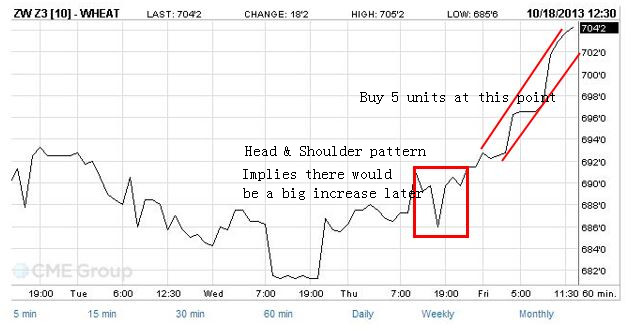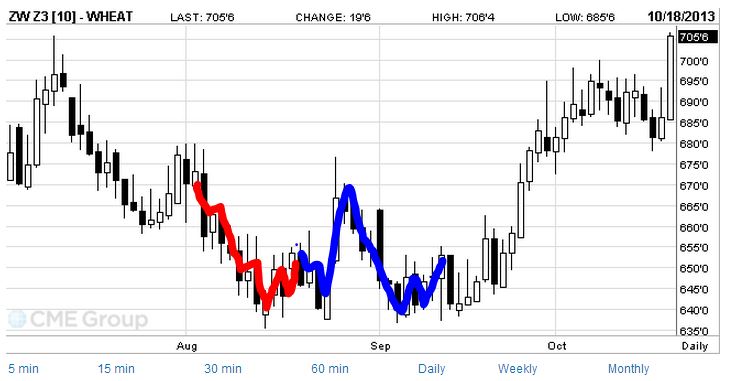WEEK 5
Keep the day trading simple and think like a mouse
I believe this week, every one in our class work really hard to figure out the futures price & spot price and the trend of price if there is a sudden big shock in demand and supply situation. As for me, it took me a lot of time to get familiar with Mr. Theory, as a result, I could only call Mr. Practice this morning.
So what can we do if we only have the opportunity for day trading? I am thinking in this way: if you are just starting day trading, then focus on keeping the trading plan simple and don’t think about each trade as the greatest potential trade of the century. You are a mouse looking for crumbs on a daily basis. What is it they say? An elephant gets mighty big eating peanuts. Swing traders are seated at the banquet table. Day traders are mice. So let’s keep this analogy at the forefront of us one day traders’ trading mind.
Strategy: Hedging
I took the long positions of Wheat December and short positions of Soybean March (but I chose the wrong futures to short, explain later).
Wheat December 2013
 Previous trend: There was a Head & Shoulder pattern in the red rectangle, which implied that there would be a big increase after the second shoulder. The fact confirmed this implication and after a relatively lower lever on Wednesday, the price for December Wheat increased from around $6.84 to $6.96 early this morning. Then there was a stable increasing trend as showed between two red lines.
Previous trend: There was a Head & Shoulder pattern in the red rectangle, which implied that there would be a big increase after the second shoulder. The fact confirmed this implication and after a relatively lower lever on Wednesday, the price for December Wheat increased from around $6.84 to $6.96 early this morning. Then there was a stable increasing trend as showed between two red lines.
What I predict: I believe the increasing trend will continue for several days so I took 5 long positions when the price was relatively stable at $7.02. Notice the rising rate is high today.
Soybean March 2014
 The reason why I said I chose the wrong futures is that the price of March Soybean should be increase afterwards.
The reason why I said I chose the wrong futures is that the price of March Soybean should be increase afterwards.
Between the two red lines, there is a typical pattern that implies a ascending trend – Top flat, bottom rising. So the spread between this pair of futures would be smaller. But as mentioned before, the increasing rate of wheat is really high and that of soybean is relatively lower, therefore, there is a potential opportunity to gain profit based of price spread trading. But, in case of loss, I will watch the trend carefully.
A useful method to predict the future trend – Elliott Wave Theory
I knew this theory in the Technical Analysis Of The Financial Markets by John Murphy, I am impressed by its ability to predict where a market will head next. The Elliott wave looks like this:
Elliott proposes, as well, that all price moves on the market are divided into (one circle):
- five waves in the direction of the main trend (waves 1 to 5);
- three corrective waves (waves a,b,c ).
The waves are divided into:
- impulses that create a directed trend (bull or bear) and cause the market to move very actively (waves 1, 3, 5, a, c);
- corrections (rollbacks) that are characterized by moving against the trend (waves 2, 4, b).
Applied in predicting the market:
It took me some time to find a typical Elliott wave in the real market, which could be a weakness of this method. Market changes all the time and is not consistent with any typical patterns.
As we can see from the above diagram, there are two circles during the period. These two circles are absolutely consistent with Elliott wave, which includes five waves in the direction of the main trend and three corrective waves. Suppose you are in the fifth wave of one circle, then you can predict that the price will go up in the future, but be careful with the seventh wave that is falling.
The red circle and blue circle show two opposite directed trend, but the principle is the same, just remember the direction between two adjacent wave will be opposite.
Mia’s Happy Time this week – Do you wanna eat like a trader in the Wall Street?
Being a foodaholic for many years, I am always trying to combine my favorite with our game since the first trading week. Since I cannot be a trader in the Wall Street right now, I decide to eat like them!
I saw a video on Bloomberg.com when tried to find interesting stuff related to trading.
For breakfast, traders like to eat breakfast pizzas topped with eggs, cheese, bacon

and sausage.
One Wall Street pizza joint says it gets orders for as many as 15 breakfast pies every Friday from the boys at Nomura, a Japanese brokerage giant that has vast offices in New York.
 For lunch, it’s on to burgers. Traders at Goldman Sachs like burgers with hand-cut fries at the Hideaway, a neighborhood bar in Tribeca, Bloomberg reports.
For lunch, it’s on to burgers. Traders at Goldman Sachs like burgers with hand-cut fries at the Hideaway, a neighborhood bar in Tribeca, Bloomberg reports.

Dinner is practically a stereotype on a plate, with Smith & Wollensky serving traders ribeye and lamb chops with lobster on the side.
Well, it seems that eating like a trader in Wall Street is not that healthy. But, it looks good…
Have a great weekend! Enjoy the food!
Mia



